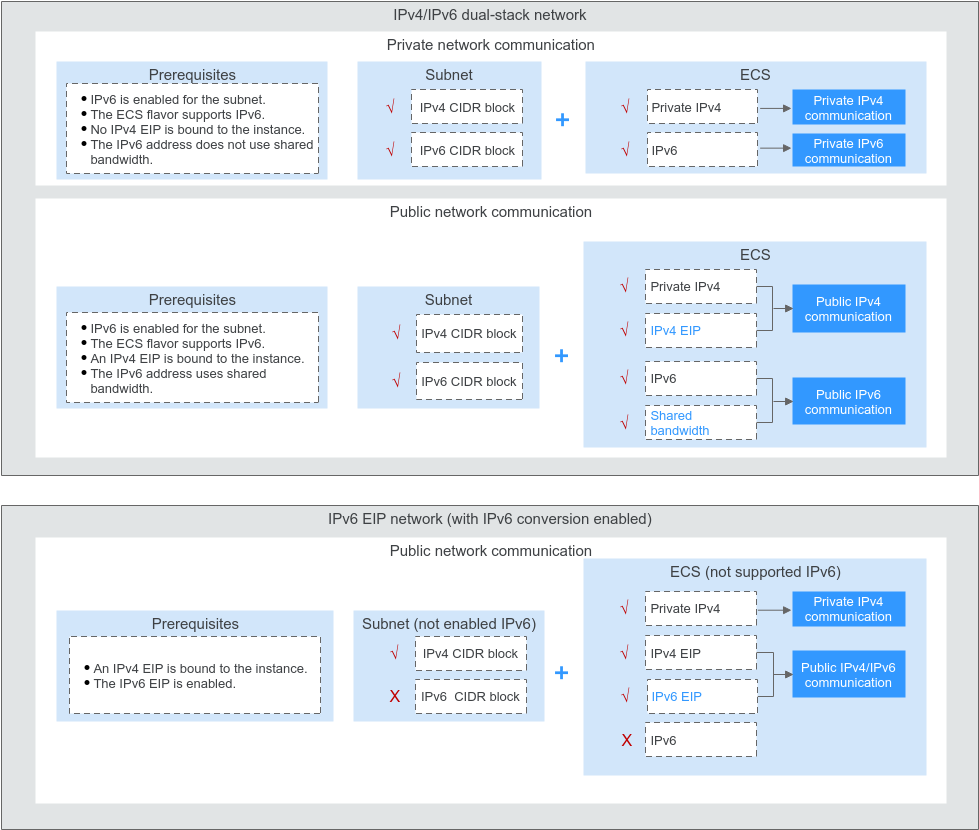IPv6 EIP
Overview
Both IPv4 and IPv6 EIPs are available. You can assign an IPv6 EIP or map an existing IPv4 EIP to an IPv6 EIP.
After the IPv6 EIP function is enabled, you will obtain both an IPv4 EIP and its corresponding IPv6 EIP. External IPv6 addresses can access cloud resources through this IPv6 EIP.
IPv4 EIPs are billed. IPv6 EIPs are currently free, but will be billed at a later date (price yet to be determined).
Application Scenarios of IPv4/IPv6 Dual Stack
If your ECS supports IPv6, you can use the IPv4/IPv6 dual stack. Table 1 shows the example application scenarios.
Application Scenario |
Description |
Requirement |
IPv4 or IPv6 Subnet |
ECS |
|---|---|---|---|---|
Private IPv4 communication |
Your applications on ECSs need to communicate with other systems (such as databases) through private networks using IPv4 addresses. |
|
IPv4 CIDR Block |
Private IPv4 address: used for private IPv4 communication. |
Public IPv4 communication |
Your applications on ECSs need to communicate with other systems (such as databases) through public IPv4 addresses. |
|
IPv4 CIDR Block |
|
Private IPv6 communication |
Your applications on ECSs need to communicate with other systems (such as databases) through private IPv6 addresses. |
|
|
|
Public IPv6 communication |
An IPv6 network is required for the ECS to access the IPv6 service on the Internet. |
NOTE:
For details, see Setting Up an IPv6 Network. |
|
|
For details, see IPv4 and IPv6 Dual-Stack Network.
Application Scenarios of IPv6 EIP
If you want an ECS to provide IPv6 services but the ECS does not support IPv6 networks or you do not want to build an IPv6 network, you can use IPv6 EIP to quickly address your requirements. For details about application scenarios and resource planning, see Table 2.
Application Scenario |
Description |
Requirement |
IPv4 or IPv6 Subnet |
ECS |
|---|---|---|---|---|
Public IPv6 communication |
You want to allow an ECS to provide IPv6 services for clients on the Internet without setting up an IPv6 network. |
|
IPv4 CIDR Block |
|
Application Scenarios and Resource Planning of IPv6 Networks

Enabling IPv6 (Assigning IPv6 EIPs)
- Method 1:
Select the IPv6 EIP option when you assign an EIP by referring to Assigning an EIP and Binding It to an ECS so that you can obtain both an IPv4 and an IPv6 EIP.
External IPv6 addresses can access cloud resources through this IPv6 EIP.
- Method 2:
If you want an IPv6 EIP in addition to an existing IPv4 EIP, locate the row that contains the target IPv4 EIP, click More in the Operation column, and select Enable IPv6 EIP. Then, a corresponding IPv6 EIP will be assigned.
After the IPv6 EIP is enabled, you will obtain both an IPv4 EIP and an IPv6 EIP. External IPv6 addresses can access cloud resources through this IPv6 EIP.

There is no adverse impact on the cloud resources bound with existing IPv4 EIPs.
Configuring Security Groups
After IPv6 EIP is enabled, add inbound and outbound security group rules to allow packets to and from the IP address range 198.19.0.0/16. Table 3 shows the security group rules. IPv6 EIP uses NAT64 to convert the source IP address in the inbound direction to an IPv4 address in the IP address range 198.19.0.0/16. The source port can be a random one, the destination IP address is the private IPv4 address of your local server, and the destination port remains unchanged.
For details, see Virtual Private Cloud User Guide.
Disabling IPv6 EIP
If you do not need the IPv6 EIP, locate the row that contains its corresponding IPv4 EIP, click More in the Operation column, and select Disable IPv6 EIP. Then, the IPv6 EIP will be released. You will only have the IPv4 EIP.
Feedback
Was this page helpful?
Provide feedbackThank you very much for your feedback. We will continue working to improve the documentation.See the reply and handling status in My Cloud VOC.
For any further questions, feel free to contact us through the chatbot.
Chatbot








